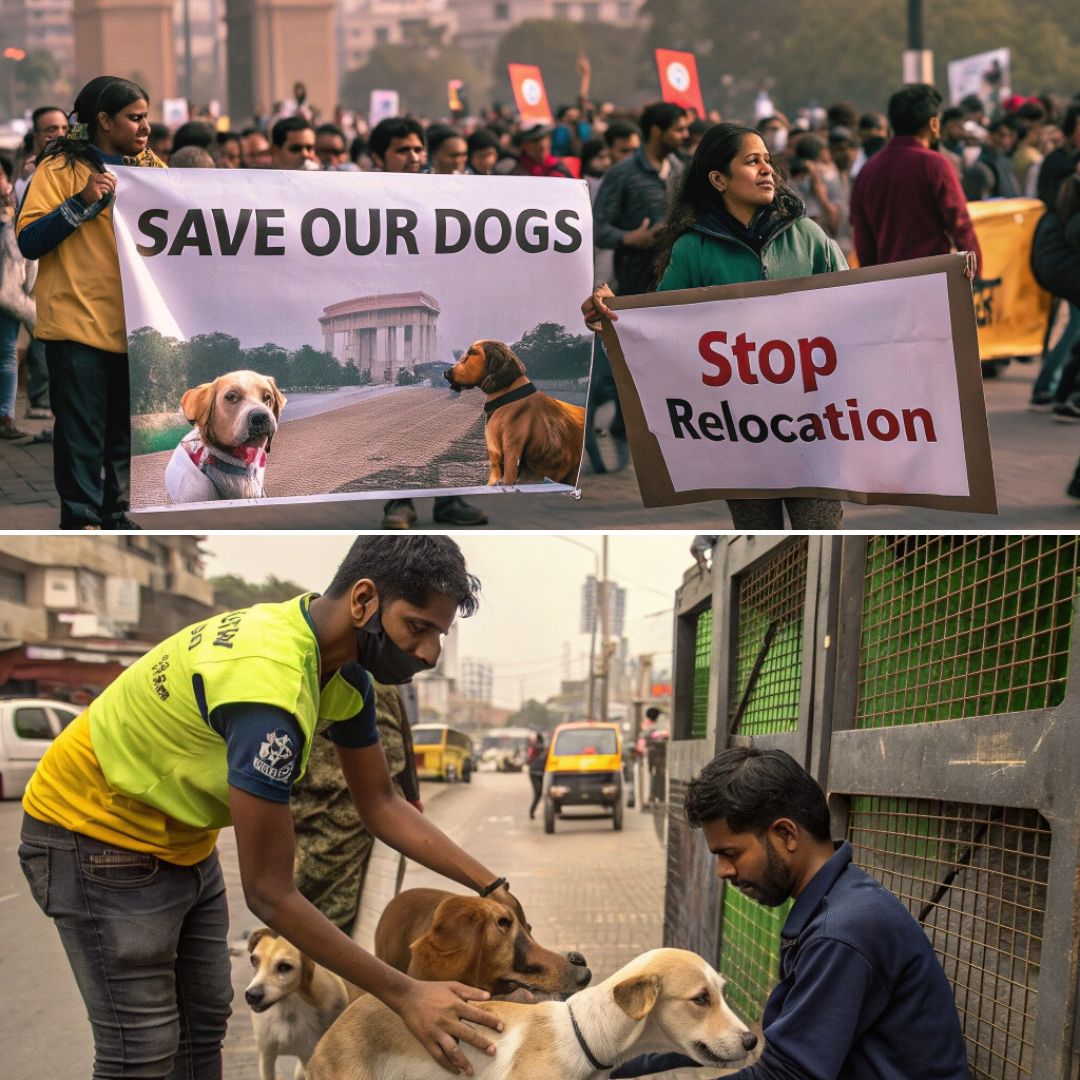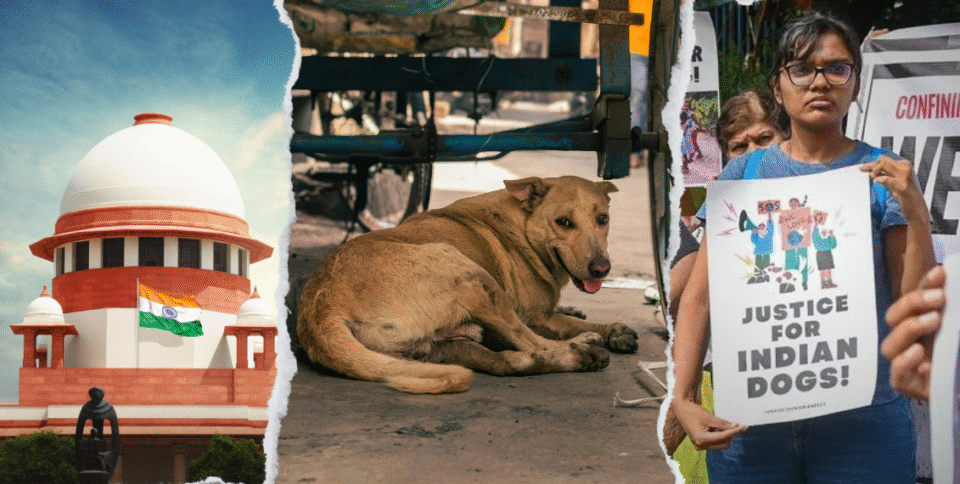New Delhi, August 22 (Updated), 2025: The debate over the fate of stray dogs in Delhi and across India has taken a dramatic turn. On August 22, 2025, the Supreme Court of India stayed its earlier August 11 order that prohibited the release of stray dogs once picked up from the Delhi National Capital Region (NCR). This crucial development by a three-judge bench, comprising Justice Vikram Nath, Justice Sandeep Mehta, and Justice NV Anjaria, lays down that dogs after sterilisation, deworming, and immunisation, should be released back to their original locations. Only dogs found infected or suspected to be infected with rabies, or exhibiting aggressive behaviour, will be excluded from release. These dogs should be held separately, in shelters, following necessary treatment. The ruling expands beyond Delhi-NCR, applying similar compliance with Animal Birth Control (ABC) Rules nation-wide, and signals the Court’s intent to shape a comprehensive national policy on street dogs.
What Happened Till Today?
1. The Triggering Incident
2. Supreme Court’s August 11 Order
3. Outpouring of Responses and Widespread Protests
4. The Stay and the Expanded Scope (August 22, 2025)
The new directions are: Dogs must be sterilised, dewormed, vaccinated, and released back where found, except if infected with/suspected rabies or aggressive such dogs may be sheltered post-treatment. Orders for creating dog shelters and pounds remain. Restrictions introduced on public feeding of stray dogs; dedicated feeding areas to be set up.
5. The Rationale for the Stay
New Delhi, August 14, 2025: Delhi police on Monday detained several animal rights activists, rescuers, caregivers, and dog lovers who had gathered at India Gate to protest a recent Supreme Court order. The detention followed the Supreme Court of India’s order on August 11,2025 of directing that all the stray dogs in Delhi and the National Capital Region (NCR) be moved into shelters within eight weeks. Protesters, holding placards and chanting slogans, argued that the decision is both unfair to the animals and impractical to carry out.
The Supreme Court issued these directions while hearing a case on stray dog attacks on August 11, 2025 which gas triggered a strong nation wide debate for serious public safety concern and also about the natural justice and animal rights of the animals. The bench, led by Justices J B Pardiwala and R. Mahadevan, had, in their order termed the situation “extremely grim” and stressed that infants and young children must not, at any cost, fall victim to rabies.
Solicitor General Tushar Mehta during the hearing had sought “something to be done” against the “menace of stray dog bites”. “We can’t sacrifice our children merely because few individuals feel that they are animal lovers or something,” he said.
The apex Court in its order also instructed municipal bodies to set up shelters for around 5,000 dogs, with enough trained staff to handle sterilisation and vaccination, and made it clear that once taken off the streets, the dogs should not be released back.
This order comes at a time when India is seeing a worrying surge in dog bite incidents and rabies cases. In Delhi alone, more than 26,000 dog bite cases have been reported so far this year. Across the country, the numbers are far higher, with millions of bites reported annually. While many citizens support stronger measures to prevent attacks, animal welfare groups warn that mass sheltering could cause suffering to the dogs, violate existing laws, and disrupt vaccination drives – raising the question: how can public safety be protected while still treating animals humanely?
Why the Court Acted ?
India is struggling with an escalating dog bite crisis. In 2024 alone, the country recorded 37.17 lakh dog bite cases – an average of over 10,000 incidents every single day. Rabies, though entirely preventable, remains a deadly threat.
Official government data paints a puzzling picture: only 21 rabies deaths were recorded in 2022. But WHO data – based on Indian government and independent sources reported 305 deaths for the same year. The WHO’s modelling estimates are far grimmer: 18,000-20,000 rabies deaths annually in India, accounting for over 36% of the global burden, with most victims being children under 15.
The capital has seen a steep rise in bites:
-
26,334 cases reported so far in 2025, including 49 rabies deaths
-
35,198 animal bite incidents between January and June 2025
-
More than 65,000 stray dogs sterilised and vaccinated in the first half of 2025
Yet sterilisation coverage remains below the 70-80% threshold experts say is needed to effectively control populations.
Protest Erupts at India Gate
Within hours of the Supreme Court’s order, 40-50 animal rights activists, rescuers, and dog caregivers gathered at India Gate carrying placards reading “Dogs are Delhi’s citizens too” and “Vaccinate, do not incarcerate.” They argued that Delhi’s existing shelters – already overcrowded and under-resourced could not house the city’s estimated one million stray dogs without causing severe distress, disease outbreaks, and cruelty.

Police detained several protesters, citing security measures ahead of Independence Day and the Parliament’s monsoon session.
Organisations such as PETA India and the Federation of Indian Animal Protection Organisations (FIAPO) condemned the order as “illegal” and “illogical,” promising to challenge it in court. FIAPO pointed out that similar in-situ sterilisation models have brought rabies cases near zero in Jaipur, Goa, and internationally in the Netherlands.
The Shelter Capacity Problem
Across NCR cities, shelter infrastructure is severely lacking:
-
Gurgaon: 50,000 stray dogs, only two operational shelters (capacity 50 each), two under construction
-
Ghaziabad: 48,000 stray dogs, minimal facilities
-
Noida: Estimates up to 1.5 lakh stray dogs, only four private shelters yet reported 73,754 dog bite cases in the past seven months
Animal welfare experts warn that mass confinement of healthy dogs is impractical, costly, and counter productive. International studies caution against the “vacuum effect” removing territorial dogs only for new, unvaccinated ones to move in, often worsening rabies spread.
Laws and Regulations
Stray dog management isn’t just a matter of civic action, it’s also shaped by a web of laws, rules, and international guidelines. Understanding them is crucial, because they define what authorities can and cannot do.
-
The Animal Birth Control (ABC) Rules, 2023, under the Prevention of Cruelty to Animals Act, make sterilisation and vaccination the only legal ways to manage stray dog populations. After these procedures, dogs must be released back to the same location.
-
Culling or relocating dogs in bulk is prohibited unless they are incurably ill or pose an immediate, proven threat to human life.
-
The Prevention of Cruelty to Animals Act, 1960 protects all animals from unnecessary pain and suffering, with penalties for abuse or inhumane treatment.
-
The Indian Penal Code (IPC) Sections 428 and 429 criminalise killing or maiming animals, with imprisonment of up to five years.
-
Supreme Court Orders have repeatedly upheld the ABC Rules, stating that human safety and animal welfare must be balanced.
-
World Health Organization (WHO) & World Organisation for Animal Health (WOAH) recommend that countries adopt mass vaccination, sterilisation, and public education instead of culling, calling it the only sustainable rabies control method.
-
European Union Animal Welfare Laws require that any captured street animals be housed in humane conditions and that euthanasia be a last resort.
Alternatives to Mass Removal of Stray Dogs
While the Supreme Court’s order aims to address public safety concerns, experts say there are humane, long-term solutions that have worked both in India and abroad. These strategies not only control stray populations but also ensure animal welfare and community safety.
1. Large-Scale Sterilisation and Vaccination Drives
Mass sterilisation and vaccination, followed by returning dogs to their territories, is considered the most effective long-term solution by the WHO. This approach prevents population growth and creates stable, disease-free dog groups. Example: Jaipur’s sterilisation programme with NGO Help in Suffering significantly reduced stray population growth and rabies cases. Similarly, Sri Lanka’s national rabies vaccination drive starting in 2007 cut human rabies deaths by over 50% within five years.
2. Community Dog Care and Management
Local residents can play an active role in feeding, monitoring, and vaccinating community dogs. Healthy, vaccinated dogs prevent new unvaccinated strays from moving in the “vacuum effect.” Example: In Alappuzha, Kerala, community volunteers oversee vaccination and awareness drives. Istanbul, Turkey, uses a similar model, keeping sterilised dogs in their territories with community care and microchipping for tracking.
3. Stricter Pet Ownership Rules
Reducing pet abandonment is key to curbing stray populations. Mandatory pet registration, sterilisation for non-breeding pets, and strict penalties for abandonment have proven effective. Example: Sikkim combined strict pet licensing with sterilisation campaigns to steadily reduce strays. Singapore enforces microchipping, licensing, and heavy fines for abandonment, keeping street dog numbers low.
4. Improved Waste Management
Stray dogs thrive where food waste is easily available. Limiting their access to garbage can naturally reduce population density. Example: Mysuru’s strong waste management system has kept stray dog density relatively low. In Bhutan’s capital Thimphu, waste control combined with sterilisation drives cut dog bite incidents by over 80% in some areas.
5. Public Education and Awareness Campaigns
Teaching communities, especially children – how to behave around dogs and the importance of post-bite treatment saves lives. Example: India could replicate the success of the Pulse Polio campaign for rabies awareness. The Philippines runs school-based rabies education programmes that have reduced bite cases among children significantly.
What the World Does to Stray Dogs?
Globally, countries that have successfully reduced rabies deaths and stray dog populations share some common strategies:
-
Netherlands: Achieved zero stray dogs through compulsory pet registration, nationwide sterilisation, public education, and strict anti-abandonment laws.
-
Sri Lanka: Uses an island-wide dog vaccination programme, door-to-door campaigns, and community sterilisation clinics to reduce rabies cases dramatically.
-
Thailand: Combines mass dog vaccination with temple-based dog care systems, integrating cultural norms into policy.
-
Brazil: Runs annual National Rabies Vaccination Days with free vaccines for pets and strays, paired with public awareness drives.
-
United States: Enforces strict pet licensing, leash laws, and low-cost spay/neuter clinics, coupled with heavy penalties for abandonment.
-
Bhutan: Has adopted a humane “Catch-Neuter-Vaccinate-Release” (CNVR) programme supported by global NGOs, resulting in rabies control without mass killing or confinement.
The Supreme Court’s order stems from a very real and urgent concern: every child deserves to feel safe walking to school, playing in parks, or cycling through their neighbourhood without the fear of a stray dog attack. For parents, these fears are not abstract, they are grounded in daily encounters and the alarming rise in bite cases. Yet, the path chosen to address this fear must be as carefully considered as the problem itself.
Rabies is 100% preventable, and the tools to control it – vaccination, sterilisation, and public awareness have been proven to work in multiple parts of the world. But in India, the challenge lies not in a lack of knowledge, but in inconsistent implementation. Vaccination drives often run in short bursts instead of sustained campaigns, sterilisation targets fall short of the stray dog birth rate, and many communities remain unaware of the importance of immediate post-bite treatment.
The push to eliminate rabies by 2030 is part of a global commitment that India has publicly endorsed. Yet, if the country focuses solely on short-term containment without investing in humane, evidence-based measures, it risks creating a cycle where neither people nor animals are truly safe. Delhi’s ongoing debate reflects a much larger national dilemma, can we find a way to protect our citizens while also upholding compassion and scientific best practices for the animals that share our streets? Or will we allow fear to overshadow long-term, sustainable solutions?

